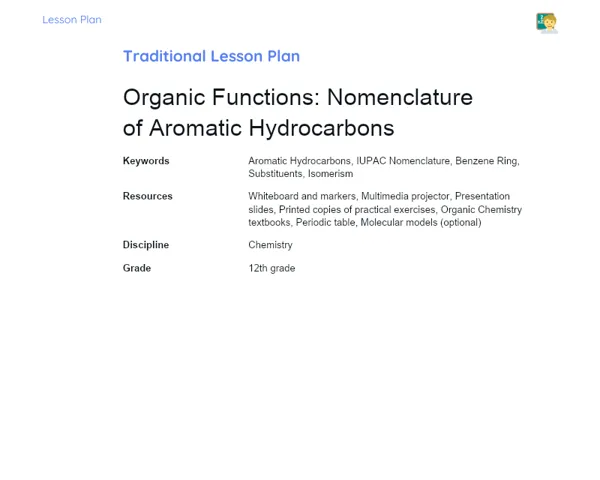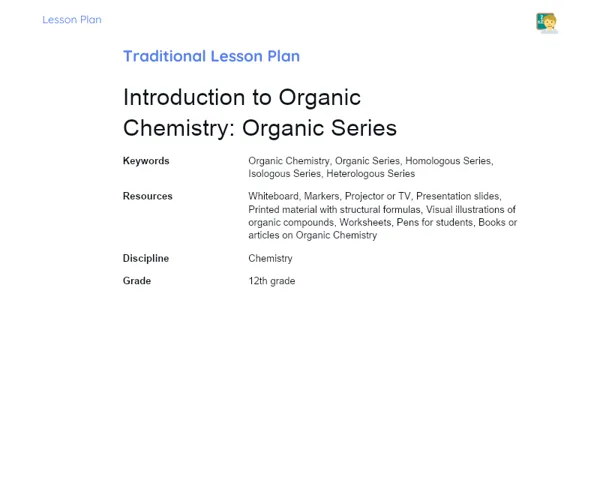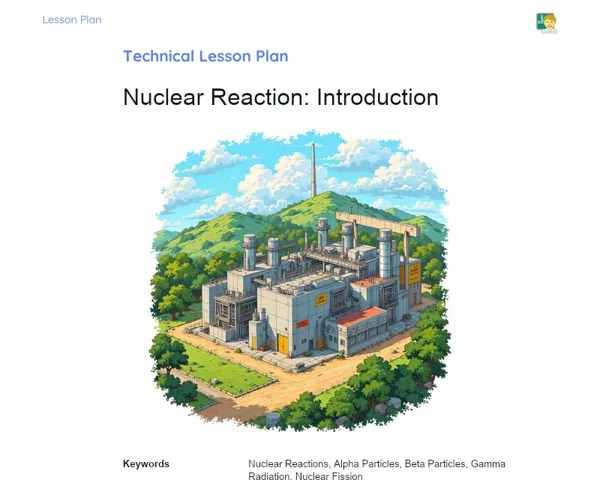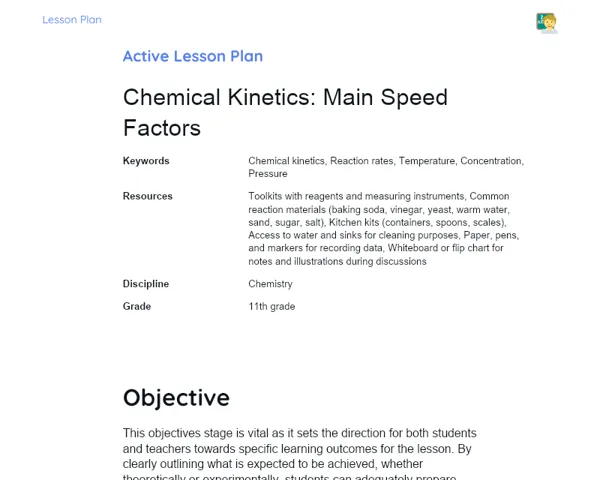Lesson Plan | Lesson Plan Tradisional | Electrochemistry: Nernst Equation
| Keywords | Electrochemistry, Nernst Equation, Electrode Potential, Non-standard Conditions, Practical Calculations, Guided Examples, Gas Constant, Faraday Constant, Temperature in Kelvin, Reaction Quotient, pH Sensors, Batteries, Fuel Cells |
| Resources | Whiteboard, Markers, Projector or TV for presentations, Slides or explanatory transparencies, Printed copies of examples and exercises, Scientific calculators, Tables of constants (R, F) and standard potentials (E°), Thermometer (for discussing temperature) |
Objectives
Duration: 10 - 15 minutes
This stage aims to give students a clear insight into the lesson objectives. By detailing what they will learn and the skills needed, students will be better equipped to absorb the content and understand the practical application of the Nernst equation. This sets a strong foundation for future learning and ensures students know what is expected of them.
Objectives Utama:
1. Explain the Nernst equation and its components.
2. Demonstrate how to use the Nernst equation to calculate the potential difference of a cell under non-standard conditions.
3. Provide practical, guided examples to enhance students' grasp of the application of the Nernst equation.
Introduction
Duration: 10 - 15 minutes
This stage aims to engage students and illustrate why the Nernst equation is important. By offering an overview and intriguing facts about the topic, students can appreciate its real-world relevance, which heightens their interest and eagerness to learn.
Did you know?
Did you know that the Nernst equation principles help in crafting pH sensors? These sensors are vital in various sectors, from the food industry to wastewater treatment, as they maintain pH levels within a safe range, facilitating effective chemical and biological processes.
Contextualization
Electrochemistry is a fascinating branch of chemistry that examines the interplay between electricity and chemical reactions. One critical concept in this field is the Nernst equation, which helps us calculate the potential difference in an electrochemical cell, especially when conditions deviate from the standard state. This understanding is crucial, particularly as we use batteries and cells in our everyday life, like those in mobile phones and laptops.
Concepts
Duration: 50 - 60 minutes
This stage’s objective is to provide a comprehensive and practical understanding of the Nernst equation, enabling students to apply their theoretical knowledge in real calculations. By examining specific components and tackling practical problems, they can strengthen their grasp and develop the skills necessary to utilize the Nernst equation in various contexts. The proposed questions will reinforce learning and ensure students can confidently apply the equation on their own.
Relevant Topics
1. Introduction to the Nernst Equation
2. Define the Nernst equation, underlining its utility in calculating electrode potential under non-standard conditions. The equation is articulated as: E = E° - (RT/nF) * ln(Q), where E represents electrode potential, E° signifies standard electrode potential, R is the universal gas constant, T is temperature in Kelvin, n is the number of electrons participating in the reaction, F is Faraday's constant, and Q is the reaction quotient.
3. Components of the Nernst Equation
4. Detail each part of the Nernst equation: the gas constant (R = 8.314 J/(mol·K)), Faraday's constant (F = 96485 C/mol), temperature (T) and how to convert it to Kelvin, and the number of electrons (n) involved in the redox reaction. Explain the reaction quotient (Q) and demonstrate how it is calculated based on reactant and product concentrations.
5. Application of the Nernst Equation
6. Show how to put the Nernst equation into action while solving practical calculations. Use specific cases, like computing the potential of a galvanic cell with varying ion concentrations. Illustrate step-by-step how to input values into the equation and derive the result.
7. Practical Examples
8. Offer guided examples with different scenarios. For example, calculate the potential of a Daniell cell under these conditions: [Zn^2+] = 0.1 M and [Cu^2+] = 0.01 M. Show how to determine each component of the equation and perform the calculation.
9. Importance and Applications of the Nernst Equation
10. Discuss the significance of the Nernst equation in real-life contexts like pH sensors, batteries, and fuel cells. Emphasize its foundational role in the understanding and development of electrochemical technologies.
To Reinforce Learning
1. 1. Calculate the potential of a galvanic cell where the reaction is Zn(s) + Cu^2+(aq) -> Zn^2+(aq) + Cu(s), given the standard potentials E°(Zn^2+/Zn) = -0.76 V and E°(Cu^2+/Cu) = +0.34 V, under the conditions: [Zn^2+] = 0.5 M and [Cu^2+] = 0.01 M, at 25°C.
2. 2. An electrochemical cell reacts as follows: Ag^+(aq) + Cl^-(aq) -> AgCl(s), with E°(Ag^+/Ag) = +0.80 V and E°(Cl^-/Cl2) = +1.36 V. Calculate the cell's potential when [Ag^+] = 0.01 M and [Cl^-] = 0.1 M, at 25°C.
3. 3. Determine the potential of a cell composed of these half-reactions: Fe^3+(aq) + e^- -> Fe^2+(aq) with E° = +0.77 V and Cr^3+(aq) + 3e^- -> Cr(s) with E° = -0.74 V. The concentrations are [Fe^3+] = 0.1 M, [Fe^2+] = 0.01 M and [Cr^3+] = 0.01 M, at 25°C.
Feedback
Duration: 15 - 20 minutes
This stage aims to ensure students can practically and independently apply the Nernst equation. The comprehensive discussion of the questions addressed serves to clear up any confusion and reinforce understanding. The engagement questions promote critical thinking and encourage students to apply their knowledge in real-world scenarios, fostering more profound and meaningful learning.
Diskusi Concepts
1. 1. Question 1: To find the potential of the galvanic cell, we apply the Nernst equation as follows:
Given: E°(Zn^2+/Zn) = -0.76 V and E°(Cu^2+/Cu) = +0.34 V. Overall reaction: Zn(s) + Cu^2+(aq) -> Zn^2+(aq) + Cu(s). Standard potential of the cell (E°cell): E°(Cu^2+/Cu) - E°(Zn^2+/Zn) = 0.34 V - (-0.76 V) = 1.10 V. Q (reaction quotient): [Zn^2+]/[Cu^2+] = 0.5/0.01 = 50. Nernst equation: E = E° - (RT/nF) * ln(Q), with T = 298 K, R = 8.314 J/(mol·K), F = 96485 C/mol, n = 2. Calculation: E = 1.10 V - (8.314 * 298 / (2 * 96485)) * ln(50) ≈ 1.10 V - 0.0296 * 3.91 ≈ 0.99 V.
Hence, the cell's potential is roughly 0.99 V. 2. 2. Question 2: For the electrochemical cell with the reaction Ag^+(aq) + Cl^-(aq) -> AgCl(s):
Given: E°(Ag^+/Ag) = +0.80 V and E°(Cl^-/Cl2) = +1.36 V. Overall reaction: Ag^+(aq) + Cl^-(aq) -> AgCl(s). Standard potential of the cell (E°cell): E°(Ag^+/Ag) - E°(Cl^-/Cl2) = 0.80 V - 1.36 V = -0.56 V. Q (reaction quotient): [Ag^+][Cl^-] = 0.01 * 0.1 = 0.001. Nernst equation: E = E° - (RT/nF) * ln(Q), with T = 298 K, R = 8.314 J/(mol·K), F = 96485 C/mol, n = 1. Calculation: E = -0.56 V - (8.314 * 298 / 96485) * ln(0.001) ≈ -0.56 V - 0.0257 * (-6.91) ≈ -0.56 V + 0.177 ≈ -0.38 V.
The potential of the cell rounds to about -0.38 V. 3. 3. Question 3: For the cell made up of the half-reactions:
Given: E°(Fe^3+/Fe^2+) = +0.77 V and E°(Cr^3+/Cr) = -0.74 V. Overall reaction: 3Fe^2+(aq) + Cr^3+(aq) -> 3Fe^3+(aq) + Cr(s). Standard potential of the cell (E°cell): E°(Fe^3+/Fe^2+) - E°(Cr^3+/Cr) = 0.77 V - (-0.74 V) = 1.51 V. Q (reaction quotient): [Fe^3+]^3/[Fe^2+]^3[Cr^3+] = (0.1)^3 / (0.01)^3 * 0.01 = 10^3 / 10^-2 = 10^5. Nernst equation: E = E° - (RT/nF) * ln(Q), with T = 298 K, R = 8.314 J/(mol·K), F = 96485 C/mol, n = 3. Calculation: E = 1.51 V - (8.314 * 298 / (3 * 96485)) * ln(10^5) ≈ 1.51 V - 0.0257 * 11.51 ≈ 1.51 V - 0.29 ≈ 1.22 V.
Thus, the potential of the cell is approximately 1.22 V.
Engaging Students
1. What challenges do students face when applying the Nernst equation? 2. In what ways does temperature affect the outcomes derived from the Nernst equation? 3. Can you think of other real-world scenarios where the Nernst equation might be useful? 4. Why is considering the concentrations of reactants and products crucial in the Nernst equation? 5. How can the Nernst equation be utilized in modern technologies like lithium batteries and sensors?
Conclusion
Duration: 10 - 15 minutes
This stage's goal is to review the key ideas discussed during the lesson, reinforcing what students have learned. By recapping the content and linking theory to practice, students solidify their comprehension and appreciate the relevance of the material. It also serves to address any remaining queries and wrap up the lesson seamlessly.
Summary
['The Nernst equation helps calculate electrode potential under non-standard conditions.', 'Components of the Nernst equation: E, E°, R, T, n, F, and Q.', 'How to compute the reaction quotient (Q) from reactant and product concentrations.', 'Apply the Nernst equation with hands-on examples in calculations.', "The Nernst equation's importance in pH sensors, batteries, and fuel cells."]
Connection
The lesson effectively bridged theory and practice by showcasing how the Nernst equation is instrumental in calculating electrode potential under varying conditions and offering practical examples illustrating the application of theory in real-life contexts, such as calculating the potential in galvanic cells with different ion concentrations.
Theme Relevance
The Nernst equation is crucial for grasping the electrochemical reactions that occur in devices we regularly use, like batteries and pH sensors—integral in our day-to-day activities, from charging our electronics to assessing water purity. A solid understanding of this equation fosters improvements and innovations within these technologies.



